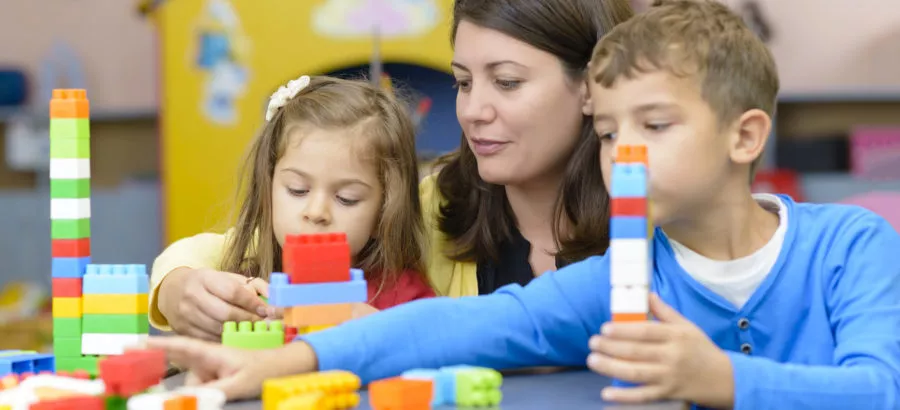On a chilly February day, I snuck into my son’s kindergarten classroom a few minutes before story time when I’d be reading to the kids. I opened the door and quietly hung up my coat, eager for a rare look at my boy interacting with his teacher and classmates. The children were gathered around tables laughing and chatting while coloring dragons for a Chinese New Year craft. No worksheets, no sight words, no math problems—just crayons and laughter. I was delighted.
At the kindergarten orientation last fall I’d been surprised (okay, aghast) to learn that the five- and six-year-olds would be given homework folders with nightly assignments, receive 90 minutes of language arts and 45 minutes of math each day, and would even use a computer and mouse to take an assessment test. My son thinks a mouse is a cute, furry rodent with a taste for cheese.
Some fellow kindergarten parents were equally puzzled and concerned, others seemed gratified that their children would hit the academic ground running, convinced that early reading and math instruction pay off in higher achievement in later grades. There’s some research to back them up.
A new study reports that students in kindergarten classes with more academic content not only show higher math and reading ability, in some cases they have better social-emotional skills.
“The results bolster the stance of researchers who believe that challenging academic content is not necessarily at odds with children’s healthy development,” the five researchers wrote in the peer-reviewed American Educational Research Journal study.
Not necessarily, they say, but what about when my son asks me why some of his friends can read and he can’t? I didn’t learn to read until the end of first grade, I tell him. I didn’t read for fun until third or fourth grade, but now I write for a living and read voraciously, with books stacked on my coffee table and nightstand. “You’ll read when you’re ready,” I say.
“Yeah, okay,” he sighs, and I wish his worries were more about a wiggly tooth and a missing matchbox car than his reading ability.
Fortunately, his teacher, Sharon Collier, works hard to strike a balance between the required kindergarten curriculum and just plain kindergarten fun.
When they’re working on numbers, for example, she has them dance the number five. When they’re learning about letters and words, they act like alligators that begin with “A” or snakes that begin with “S.”
“I’ve been doing this for 20 years,” Collier says. “I know when they’re learning, and children this age simply won’t like learning if it’s not fun.”
She has different stations in her room for play and creativity, like an art station and a house station, but there’s often not enough time for that kind of kid-directed free play except during indoor recess.
“We have a lot of students and not enough time even with a full day versus a half day,” Collier says. “Everyone in kindergarten struggles with this."
Shawnee Wood teaches kindergarten at Oakview Elementary in Stoneboro, Pennsylvania, but she says over the last decade it’s become more like second grade disguised as kindergarten. The rigor and academic expectations increased dramatically with the implementation of the No Child Left Behind (NCLB) Act and the barrage of testing that came with it.
Wood has noticed that even though the Every Student Succeeds Act, which replaced NCLB and reduces the amount of required testing, has helped turn the tide, kindergartners are still “in desperate need for appropriate amounts of social and play time.”
For the first time in 12 years, Oakview’s kindergartners have a morning recess break as well as afternoon, and Wood has noticed the difference in their growth.
“When they have time in the morning and afternoon to have free play without me dictating their activities, their little bodies and minds are better able to focus on the academics,” she says. “They’re learning their sight words as well as learning how to play appropriately.”
Like Collier, Wood has been teaching for 20 years, and remembers when she a taught a letter a week and students still managed to learn how to read. But with more rigorous expectations, students who have learning issues are buried further by the strident expectations, and their behaviors worsen with the frustration.
“Over and over I say, let me teach them to be kind little citizens, to walk and take turns, to learn to love reading and writing, and the rest will come when they are ready,” she says. “Due to state standards, standardized testing, and the demands of society, it is a fight to keep the joy in kindergarten.”
Other educators have joined the fight. Becky Adrian works with first and second grade English Language Learners and believes we need to shift back to play-based education. She says some educators forget that many students are learning sight words as a second language.
“Play lets them interact as equals and gives them crucial linguistic skills necessary for academic development,” Adrian says. “Until early childhood educators have the training to develop language-neutral academics, play is the savior of language learners. Kindergarten should be a welcoming experience for all students.”
Sharon Collier’s classroom is a safe, welcoming environment where students are introduced to basic math and language arts, but also learn to do a mean hokey pokey and to “fill each other’s buckets” with kind words and actions.
“Whether or not they read by year’s end, I want all of my students to be safe and happy,” says Collier. “My job is to bring out their best.”
Learn More:
The Reading Rush: What Educators Say About Kindergarten Reading Expectations
Despite the national push to get them to read and write by year-end, most kindergartners aren’t ready.


